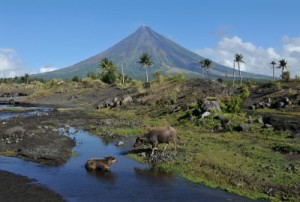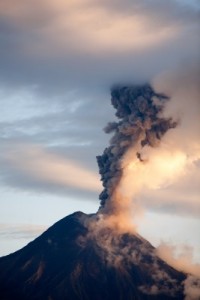The following are volcanic eruptions that occurred Tuesday, May 7, 2013. Keep in mind that the CO2 emissions from each of these volcanoes averages about 950 tonnes per day – this is Nature’s own “global warming.” Each of these volcanoes should be off limits to visitors, campers, hikers, and climbers around the summit craters.
Mayon – Luzon, Philippines
A powerful eruption from the summit crater of Mayon volcano in the Philippines occurred early morning, and killed 5 climbers and wounded at least 15 other people. They were surprised by an explosion that suddenly showered their camp with ballistic fireballs.
Reventador – Ecuador
The lava domes are active, with an occasional explosion and the emplacement of a hot avalanche or lava flow on the eastern flank where a new hot spot on the latest MODIS satellite data can be seen .
Tungurahua – Ecuador
An increase in eruptive activity is evident by continuous ash and steam emissions that are interrupted by cannon-like explosions producing ash plumes. At night, explosive activity can be seen from the summit. A significant SO2 plume can be seen on satellite data drifting to the NW.
Bagana – Bougainville Island, Papua New Guinea
Eruptions have intensified at the volcano. Over the past 2 days, several explosions have produced ash plumes rising to about 7,000 ft (2.1 km).
Batu Tara – Sunda Islands, Indonesia
An explosion produced an ash plume rising to 7,000 ft (2.1 km) altitude.
Paluweh – off shore Flores Islands, Indonesia
The Paluweh lava dome is relatively active, and is producing frequent explosions and hot rock avalanches. Hot deposits can be seen on MODIS satellite data on the eastern, southern and western flank of the dome. Several ash plumes rising to altitudes of about 7,000 ft (2.1 km) have been detected over the past few days.
Lukon-Empung – North Sulawesi, Indonesia
An explosion occurred at the Tompaluan crater that was heard up to 4 miles (6 km) away. Incandescent bombs were ejected approximately 650 feet (200 m) from the crater. The eruption followed an increase in seismic activity starting Saturday, May 4.
Papandayan – West Java
Increased seismic activity has been detected at the volcano and the alert level has been raised to 3 out of 4. Sudden explosions can occur with little warning, and there is a significant hazard to visitors around the volcano.
Cleveland – Aleutians Islands, Alaska
A large explosion occurred on Saturday, May 4, and continuous small eruptions are producing steam and ash plumes. The activity of the volcano is not monitored on ground, but is monitored by satellite data, which continues to show highly elevated surface temperatures at the summit.
Popocatepetl – Central Mexico
Emissions of steam and gas, with minor ash contents, have been venting around 1 per hour during the previous days, but continuing lava glow can be seen flowing from the summit.
Santa Maria/Santiaguito – Guatemala
The lava dome is spewing sporadic, weak explosions, with minor activity from the lava flows on the flanks of the Caliente dome.
Pacaya – Guatemala
Weak explosive activity is continuous. It cannot always be observed, but can be heard and shows on seismic recordings.
Fuego – Guatemala
Six explosions produced gray ash plumes rising as high as 1,600 feet (500 m) above the crater.
Nevado del Ruiz – Colombia
A seismic swarm, indicating a rise of magma, resurged at the volcano. The largest quake was a magnitude 2.9, 3.5 miles ( 5.4 km) beneath the Arenas crater. It was felt around the volcano.



[…] Eruptions Increase Worldwide http://www.extinctiontheory.com/volcanic-eruptions-increase-worldwide — 3. Fireballs – on the […]